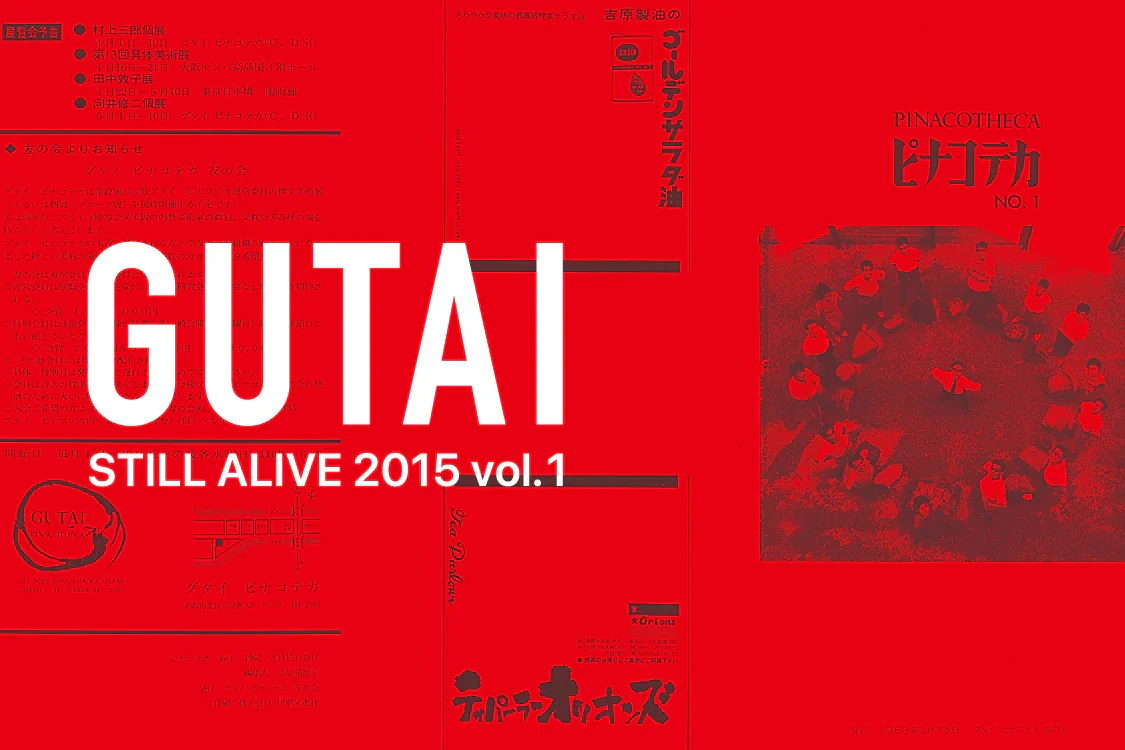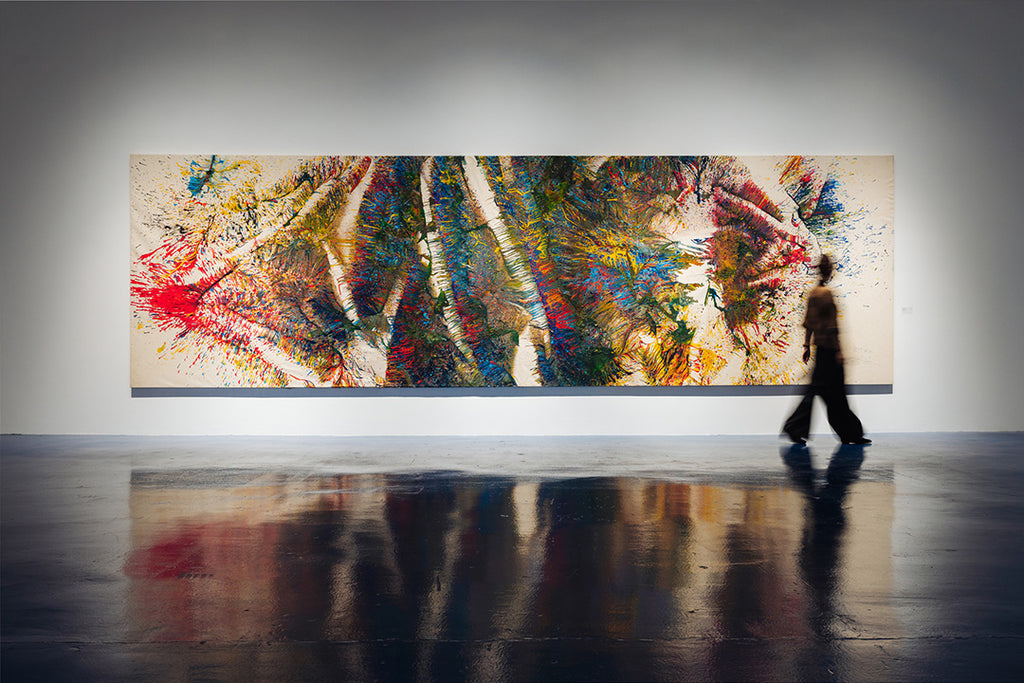ARTICLES
自知與吉原治良存在隔閡的具體藝術家金山明
GUTAI STILL ALIVE 2015 vol.1
27/35

本系列企劃為您推出關於具體美術協會的書籍《GUTAI STILL ALIVE 2015 vol.1》的數字檔案。第27期為您介紹具體成員、1952年與白髮一雄和村上三郎等人創立「0會」的藝術家金山明。金山明創作了經過縝密研究後對幾何形態進行佈局配置的平面作品,並從事過彷彿讓空間的質感發生變化一樣的裝置藝術創作。美術史學家加藤瑞穗為我們講述了金山明的藝術思想以及他與同為具體成員的田中敦子之間的關係。
自知與吉原治良存在隔閡的具體藝術家金山明
加藤瑞穗
(美術史學家)
在具體美術協會(具體)的成員當中,可能沒有一個人能比金山明(1924–2006年)看上去更不像是「具體」的藝術家了。金山在1952年與白髮一雄、村上三郎等人共同創立「0會」,後來在1955年匯入「具體」的時期,創作了一批盡量不留下筆觸或筆畫痕跡,就構圖進行縝密研究後對幾何形態進行佈局配置的平面作品。白髮一雄就這些作品點評的措辭是「這些畫作就如同對蒙德里安的純粹抽象作品進一步進行了簡化一樣」,但這一風格與一般被認為是具體主流的風格大相徑庭,甚至可以說截然相反,而後者的特點是全面凸顯繪畫行為和材料的存在感。金山做得最絕的一次是乾脆將一塊什麼也沒有畫的畫布作為作品提交給了吉原治良。這一軼事生動地反映了金山徹底的激進性,不僅限於平面作品,他還在加入具體美術協會後不久就發表了多個可以視為裝置藝術先驅的作品。
例如,將高度相當於展室的大型塑料氣球置於中央,同時在斜上方懸掛一個內部裝有電燈泡的紅手套,把周圍染成紅色的作品;在一張長達100米的細長塑料布上畫上鞋印,像鋪設道路一樣鋪在成為會場的松林公園裡的《足跡》;從鐵路公司借來鐵路公路交叉口的警報器並將其安裝在公園裡,一邊發出警報聲一邊讓紅燈閃爍不停的《警報器》等。所有這些作品都具有顯著的特點,能改變會場空間的質感,讓觀賞者意識到時間流逝並重新認識到自身在空間所處的位置。換句話說,他並沒有像許多其他具體藝術家那樣,通過激烈的筆觸或厚厚隆起的顏料來主張作為造物主的藝術家自身的存在。這一點同樣適用於他通過玩具電動汽車和手工製作的自動划線機繪制的作品系列,通過機械出現的運動軌跡更多凸顯的是時間的推移、空間的移動、以及物理原理等客觀因素,而並非藝術家的主觀。
關於金山在具體美術協會內的這種特殊性,自1972年具體解散後不久就有人曾經指出。彥阪尚嘉的論文《封閉圓環的遠方是什麼?從「具體」的軌跡中能得出何種結論?》(《美術手帖》第370號,1973年8月)被認為第一次對「具體」在戰後日本美術界的歷史意義進行了考察。在這篇文章中,金山被稱為「異常的藝術家」。此外,在初次全面討論戰後日本美術發展史的千葉成夫的《現代美術脫離史 1945~1985》(晶文社,1986年)中,金山也被特意提及,並被稱為「『具體』內部的局外人」。而且金山本人也曾明確表示,他與田中敦子一樣與行為藝術無緣,並毫無掩飾地談到了他與具體領軍人物吉原治良之間的意見分歧。
金山與吉原相互最不相容的地方就是如何對待「物質」的看法。「吉原先生聚集了嶋本等人,主張物質會對精神進行反彈。繪畫就是物質,它對精神進行的反彈就是藝術。聽到此話時,我總覺得難以理解。(中略)吉原先生到最後一直主張物質會對精神進行反彈。自己畫出的筆觸會對精神進行反彈那樣的繪畫,我是搞不懂的。」(《具體資料集》第401頁,蘆屋市文化振興財團,1993年)相對於「物」,金山更關注的可能是他本人1957年所說的「平面、空間、時間等難以分割的要素」,換言之,就是「物」與「物」之間的關係。自1970年代以來,金山之所以選擇把音樂、天文等領域作為創作主題,大概是因為其獨有的特質,他對多個要素之間存在的關係或規律表現出了濃厚興趣。
金山在1965年退出具體美術協會一事,當然起源於他與吉原之間存在這樣的意向分歧,但更切身的原因是他與吉原對田中敦子的評價存在差異,以及因吉原和田中之間的矛盾導致了田中健康狀況的惡化。金山最早發現田中的才華,並引導她走向抽象藝術世界,隨後在「0會」和「具體」中一直與田中共同活動,始終毫不吝惜地為田中提供了建言與幫助。金山與田中兩人的邂逅對彼此都具有至關重要的意義,以至於連吉原都曾經指出,是金山「發現」了田中,而田中本人也曾提到金山是給她帶來最大影響的人。總而言之,田中的作品離不開金山的存在,其作品之所以在「具體」中被認為屬於異類,尋根問底的話,原因之一是源自金山的意向。
田中在退出「具體」時,身體狀況已糟糕得連創作都難以順利進行下去,但在金山富於獻身精神的呵護和幫助下,她在20世紀60年代後半期迎來了與具體時代相比也毫不遜色,甚至還更加充實的時期,並在隨後的40年里精力充沛地持續創作了許多大型作品。進入21世紀,以歐美為主,人們從「具體」的框架中將田中分離出去,將她作為一名獨立藝術家給予高度評價時,最為之感到欣喜的莫過於金山。「具體」成立已經過了60年,現在需要比以往更加細緻入微地進行研究,以重新審視其歷史意義。對自知與吉原之間存在隔閡的金山與田中的關注,無疑為我們提供了深入了解「具體」真實面貌的重要線索之一。
(刊登於《畫廊月刊》2014年9月號)
文中提到的資訊是文章發佈當初的情況,某些部分也許已與現狀有所不同。



